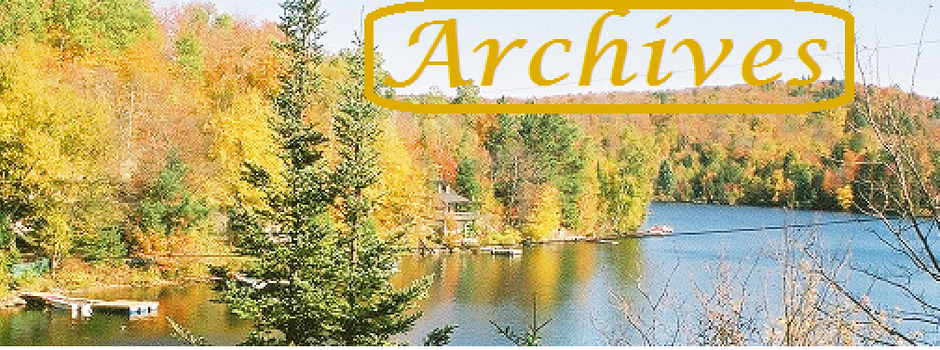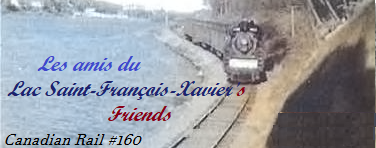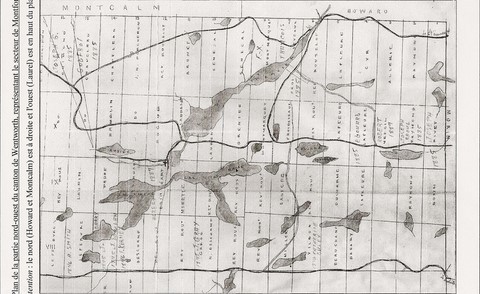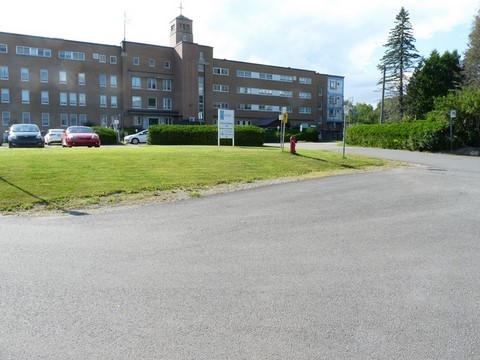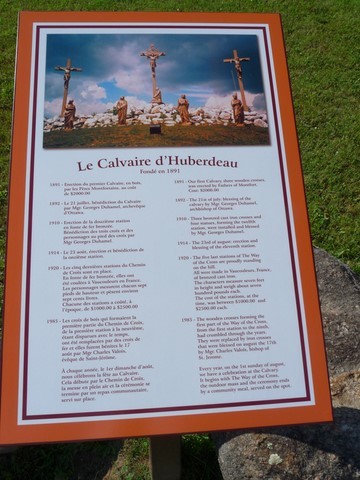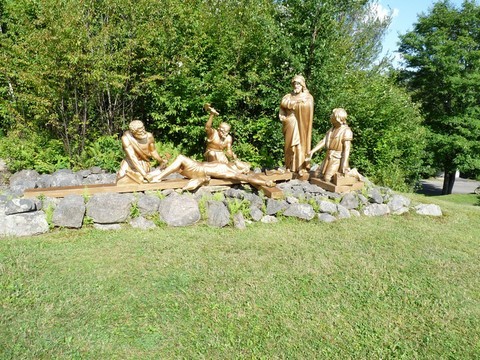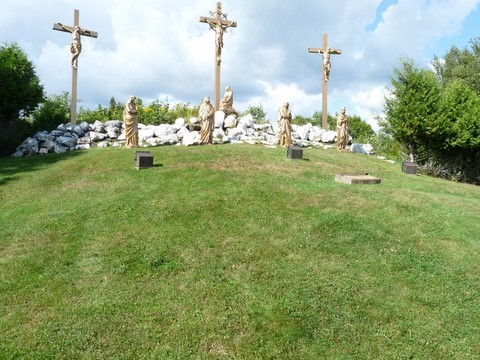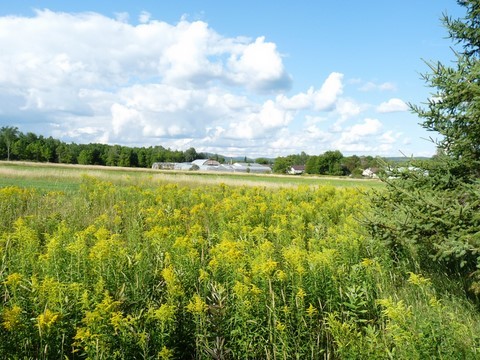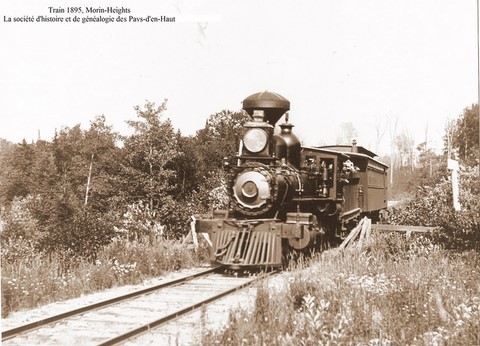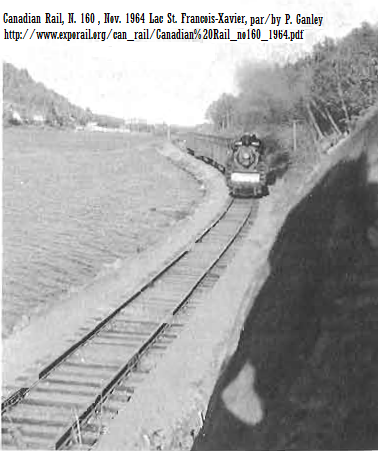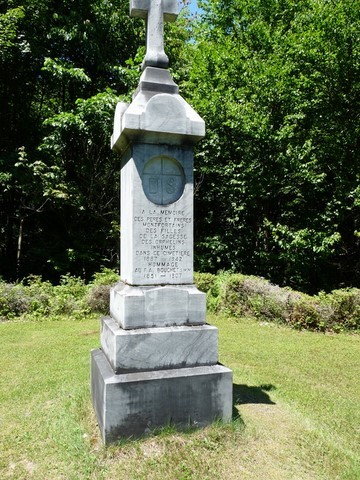Montfort
Departure of a steam engine
Colonization roads of Montfort
[Click to zoom the image] In his Société d’Histoire et du Patrimoine des Trois Villages "Le Contact" newsletter, summer 2008, Mr. Fernand Janson publishes an old subdivision plan around Lake Saint-François-Xavier.
You can see on the attached topographic map of today approximate reproduction of two existing roads at the time, crossing in long rows 10 and 11. Originally forest access roads, explains Mr. Janson, row 10's one allowed to go to the agricultural Orphanage of Notre-Dame de Montfort. It could thus be reached from Saint-Jérôme, passing by Mille-Îles. It was "before the construction of the great road of colonization, the future Road 364 West. It was also used to go to Laurel, passing West of Lakes Noir and Argenté.'' This road became the Jackson and des Montfortains Roads; while its western branch is now missing.
Concerning the road going through row 11, it headed East, towards Saint-Sauveur and, to the West, will become route Principale towards Laurel.
Carl Chapdelaine
Meanwhile, this successful project of colonization would also have generated the creation of an agricultural establishment on the Red River, in the Arundel Township which, established on more fertile grounds, could later accommodate part of the young people trained at the orphanage, thirty miles away from it.
You wiil soon be able to reach Arundel and Huberdeau by the Aerobic Corridor.
Little Mary's Hostel
At the end of 19th century, Montfort had only 30 houses which were well aligned with the Church, the presbytery, the hotel, the general store, and, farther away, the orphanage. There was also, a way apart, a nice, big white house with columns at the entrance. This would become the hostel of Little Mary.
How the redhead of sixteen years, could have left her home in Scotland and ended up in this new village of the Laurentians? What role did Mr. Brown, an importer of fine fabrics, have to play in this? Mary’s wedding photo, now known as Mme Paradis, which shone on the sideboard of the hostel, would have much to tell about this story. Fortunately, Laurette Paquin, the granddaughter of this Scottish woman, Mary, made her childhood memories come back to life through this story.
Mary was going to transform her large house into a pension-hostel for workers on weekly agreement basis. A description of this environment and the life at the Inn brings us back a century. The hot bath was taken on Saturday afternoon, in in a corner of the kitchen encircled by thick curtains. The men were okay with this ritual.
Then Mary lost her husband, a victim of a hunting accident. The body would be exposed in the house, as was the ritual of the time. It would be laid out on boards dedicated for this purpose and covered with a sheet. Mary, having learned to rely only on herself, continued to run the Inn until the day when another adverse event made her fate fall over again. Mary would then leave Montfort and ... move with her Inn!
You will discover this story, true or not, of Little Mary and her Inn in our spring 2014 Newsletter.
Carl Chapdelaine
up
First steam train
The Montfort Colonization Railway first steam train would have arrived at this village in 1894; the route was starting at the "Montfort Junction", then north of Shawbridge. It was a narrow-gauge (3 ft) railway known as «chemin de fer économique». The attached photo, dated 1895, should reflect this situation.
The two locomotives dedicated for this service, as well as cars and other specific equipment, possibly came from the Abitibi-Témiscamingue Region where this type of narrow gauge railway had just been replaced by a standard gauge one.
But as soon as the 1897, the Montfort Colonization Railway Company, which would change its name for the Montfort & Gatineau Colonization Railway Company, hoping to reach the latter region via Huberdeau, made the same move and converted the tracks to conform to the standard in use in the East of the country, with a gauge of 4 feet 8 inches and half.
Following this standardization, the Montfort junction moved to southern suburbs of Saint-Jérôme where the railway was able to make the direct connection with the CPR tracks.
Source: The Montfort Story, O.S.A. Lavallée, Canadian Rail, number 135.
http://www.exporail.org/can_rail/Canadian%20Rail_no135_1962.pdf.
More from Canadian Rail: Montréal - Montfort - Huberdeau:http://www.exporail.org/can_rail/Canadian%20Rail_no284_1975.pdf.
The last train
Route 34 : Frenieres - Lac Remi; see in: Quebec& Labrador Railways - SL 150 ; Passenger stations & stops; Canadian National Rly (1-53). route 34. http://www.railwaystationlists.co.uk/pdfcanada/quebecandlabradorrlys.pdf (p. 8)
Abandonment of the route: «This arrangement would be similar to that covering the abandonment two years ago of part of the National's picturesque Montfort Subdivision in Quebec. The adjacent photograph (p.273: close to end of document) shows a passenger train following the shores of Lac St. Francois Xavier between the villages of Montfort and Newaygo.»
http://www.exporail.org/can_rail/Canadian%20Rail_no160_1964.pdf Photo - P.Ganley
Last train (diesel) to Montfort. see picture of the steam train and the account of the last voyage p. 91: 'Farewell ': http://www.exporail.org/can_rail/Canadian%20Rail_no134_1962.pdf
Montfort Leduc
Memories I have collected from Mr. Jean-Louis Levasseur, orphan at the orphanage in the late 40’s and son in law of «Montfort Leduc», first baby boy to be baptized at the village (1883). In «Lake St. François-Xavier Newsletter», Fall 2010 (in French only; translator welcomed).
«The steam train arrived on Fridays. Among luggage, there were reels of film; the broadcasting took place on Fridays evenings for the public of the village and on Saturdays evenings for the orphans. It had repeat broadcast on Sundays when the weather was bad. The train was leaving on Mondays. There was also theatre and concerts. The Alouette quartet3 was welcomed, as was the young prodigy Gérard Barbeau, boy treble famous here and abroad.» Gérard Barbeau sings Tristesse from Chopin (Etude Op 10 No.3); YouTube
up
The origins of Montfort
In the winter 1880-1881, a group of citizens from Montreal expressed their intention to buy some lots somewhere in the Northern Townships. Their project followed the patriotic movement of colonization earlier associated to the famous ‘’Curé Labelle’’ (François-Xavier-Antoine Labelle), St. Jérôme parish priest, and combined the intention of creating an orphanage there.
So, three scouts ventured in the forests of these townships, in search of a favourable place. They arrived in the north portion of Wentworth’s Township, in dense forest, at the foot of the lake dedicated to the apostle of the Indies and Japan (Saint François-Xavier). There, close to where would later be the mill and the orphanage, they estimated to have found a place sufficiently close to Montreal, and especially to Saint-Jérôme. The ground, though rocky, appeared acceptable to them and the forest abounded in trees of good quality, an already precious resource at the time.
In Montreal, in the two months that followed and using an approximate map of the territory, about sixty brave men bought the first lots from the government, lots that the majority of the persons had never yet seen. That would be sufficient to plan for the making, one day, of a parish “which they initially agreed to name «Notre-Dame of the Lakes» considering the many lakes in the vicinity”.
The pioneers then started clearing the land; masons and carpenters bustle about; mills, sawmills and the right wing of the orphanage took shape. It was already the fall of 1881 and, needing a saw and shingles mill, etc, Mr. Joseph Bureau discovered a water concentration point. Dwellings are built there one after the other to shelter these new parishioners.
On August 24, 1883, accompanying a group of orphans, two fathers and six brothers of ‘’La Compagnie de Marie’’ (Monfortains) arrived from France to head the new establishment and to take charge of the agricultural orphanage. It is in honour of the founder of their community that the parish would finally take the name of ‘’Notre-Dame de Montfort’’.
One decade later, the railway, having already reached Saint-Sauveur, would also take the direction of this new village. Two hours and a half would soon be enough to reach the place. Meanwhile, this successful project of colonization would also have generated the creation of an agricultural establishment on the Red River, in the Arundel Township which, established on more fertile grounds, could later accommodate part of the young people trained at the orphanage, thirty miles away from it.
Sources: The major content of this article mainly comes from: «Orphelinats Agricoles de Notre-Dame de Montfort», published in Montreal, in 1883 and can be viewed at the following link:
http://www.archive.org/details/cihm_02187
up
Municipality of Wentworth-Nord
Montfort is one of the three villages of Wentworth-Nord and is located to the northeast of the municipality.




